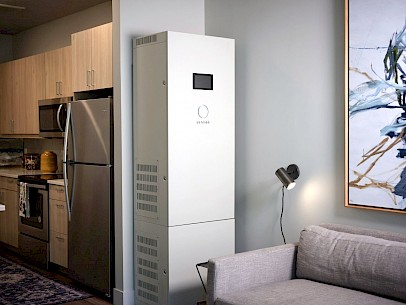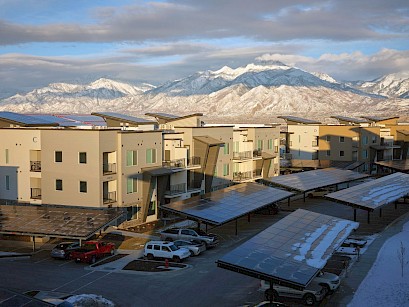The hottest amenity from developers? A power plant made of batteries
 Soleil Lofts, an apartment development in suburban Salt Lake City, offers a lot of amenities — pools, three spas, a basketball court, electric appliances, a dog park — to lure potential residents.
Soleil Lofts, an apartment development in suburban Salt Lake City, offers a lot of amenities — pools, three spas, a basketball court, electric appliances, a dog park — to lure potential residents.
But the feature that sealed the deal for Maik Kannenberg, a sales representative for a local tech firm, was a sleek, silent device: an energy storage battery.
Mr. Kannenberg’s home, like every apartment in the $156 million, 600-unit complex, includes a new ecoLinx battery made by the German company Sonnen. Charged via rooftop solar panels, these cells, roughly the size of a water heater, collectively form what’s called a virtual power plant. The system not only provides 12.6 megawatt-hours of backup power for the building, it also makes better use of the renewable power generated on site.
“If I can do a small part to make the world a better place, and make Utah a cleaner place, I’m happy to do it,” Mr. Kannenberg, 38, said.
Advances in battery storage and solar technology, coupled with the desire of utilities to expand renewable power, mean virtual power plants are fast becoming valuable tools for commercial and residential properties. Demand for more resilient power systems, recently highlighted by the failure of the Texas power grid and the rolling blackouts imposed in California to decrease wildfire risks, has also made such technology more desirable.
Batteries have commercial applications for all types of buildings, including those at many universities and corporate campuses, said CR Herro, vice president of innovation for the national homebuilder Meritage Homes.
“In the ’80s, people installed solar because they cared about doing the right thing,” he said. “Now, solar and battery systems like the one at Soleil are like putting an A.T.M. in your kitchen that spits out $20 every month.”
As more drivers switch to electric cars, property owners could increasingly see value in generating and storing energy, especially at sites where dozens of cars may need to be charged at the same time.
Many firms, especially in the energy industry, see potential in virtual power plants. OhmConnect, a California start-up, plans to build a massive system with $100 million in funding from Sidewalk Infrastructure Partners (which lists Alphabet, Google’s parent company, as an anchor partner), and Swell Energy in Los Angeles raised $450 million for home virtual power plants to help the grid.
In Utah, Soleil Lofts signed a first-of-its-kind deal with Rocky Mountain Power, which can tap the batteries as a power source. This arrangement helps the utility save generating costs while helping the developer save money, according to the Wasatch Group, the Utah developer that built and manages the apartments.
Wasatch executives see the virtual power plant as proof that batteries are a smart investment for building owners.
“The V.P.P. provides an income stream and makes this a more attractive property to rent,” said Ryan Peterson, president of Wasatch Guaranty Capital, the firm’s real estate and investment unit. “One of the reasons we’re looking at renewables and solar is that it reduces operating expenses and increases cash flow, a big deal to real estate owners.”
The Soleil project arrives at the intersection of several trends: a transition toward cleaner, renewable power; the rapidly shrinking cost for batteries and energy storage, which dropped nearly 80 percent in the last decade, according to the Boston Consulting Group; and a push by developers to reduce their environmental footprint.
Battery energy storage in the United States grew substantially last year, adding 476 megawatts of storage in the third quarter, a 240 percent increase from the previous quarter, according to the U.S. Energy Storage Monitor.
But it’s nowhere near what’s needed to support a fully renewable power system. A report by the University of California, Berkeley, exploring the shift to renewable power suggests the United States would need 150 gigawatts of storage to achieve a 90 percent clean energy grid by 2035.
“We are at a turning point,” said Mark Dyson, a clean-energy expert at RMI, a Colorado organization focused on sustainability. “Since price points have come down so much, especially for batteries, I’d expect a growing fraction of new homes will incorporate these technologies. Virtual power plants are the cheapest, most valuable thing to build next for the U.S. power system.”
Electricity use in buildings waxes and wanes throughout the day. Renewables and battery storage can smooth out that cycle, storing power when use is low and then tapping it during periods of high demand, keeping electricity costs down.
“There’s a tremendous amount of value for buildings that are energy efficient, produce renewable power and store the power to discharge at the right time,” Mr. Herro said.
 Meritage has seven demonstration projects across the country, including in Arizona, California, North Carolina and Texas, seeking to understand how buildings can better optimize the power grid and reduce energy costs. Mr. Herro said he believed more utilities would soon adopt such “load-shifting” rates.
Meritage has seven demonstration projects across the country, including in Arizona, California, North Carolina and Texas, seeking to understand how buildings can better optimize the power grid and reduce energy costs. Mr. Herro said he believed more utilities would soon adopt such “load-shifting” rates.
For Wasatch, Soleil Lofts offers both financial and marketing benefits. Potential tenants wooed by the complex’s green credentials are more likely to rent, and the entire structure has lower energy costs over time. The battery storage system has offset energy costs from common areas, Mr. Peterson said.
Wasatch began exploring renewables years ago as a means to cut costs across its portfolio, which includes roughly 20,000 apartments in the Southwest, as well as office space, hotels and some industrial holdings. The savings from solar installations didn’t quite add up, so four years ago, the company began exploring the combination of batteries and solar. Viewing Soleil as a test project, Wasatch began collaborating with Rocky Mountain Power and Sonnen, working out the technical challenges to set up the virtual power plant.
Since the partial opening of Soleil last fall, the battery storage project has met all expectations, Mr. Peterson said. The $34 million battery system, underwritten with roughly $3.3 million in grants from Rocky Mountain Power, sells energy back to the utility to cover periods of peak energy use. Residents save roughly 30 percent to 40 percent on their energy bills, Mr. Peterson said.
Projects like Soleil offer a real-time source for renewable power, said William Comeau, the vice president of customer experience and innovation for PacifiCorp, which owns Rocky Mountain Power. To meet its renewable energy target — 60 percent of total power generated by 2030 — Rocky Mountain Power needs to invest heavily in storage sites as well as smaller distribution sites like Soleil. Falling battery prices will create more opportunities to expand, he said.
Other developers have collaborated with utilities on battery storage projects. Related Companies installed a 4.8-megawatt battery at the Gateway Center in Brooklyn, turning what would have been unusable space into a storage site operated by Enel X, an energy company.
Neither company would discuss lease terms, but Luke Falk, a Related vice president, said that this kind of battery storage system could help companies like Related make money and meet sustainability goals.
You can return to the main Market News page, or press the Back button on your browser.

